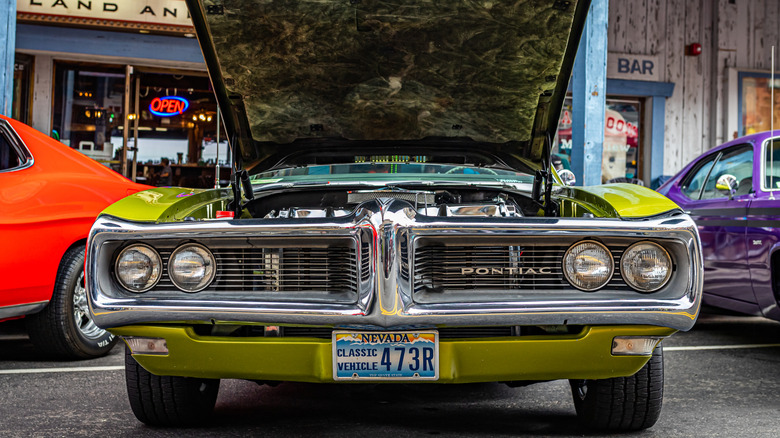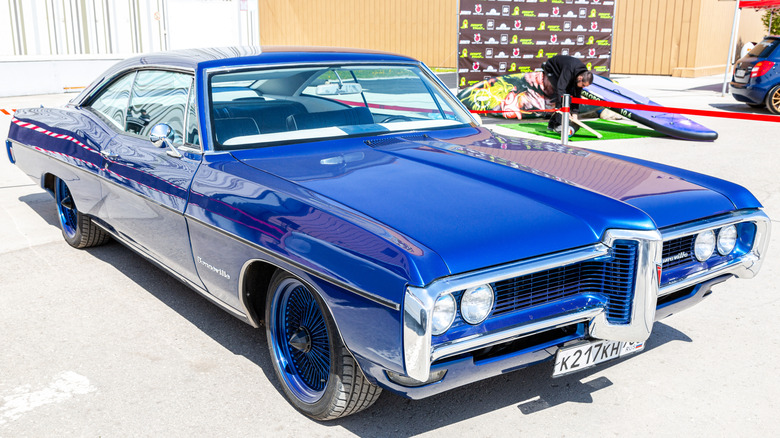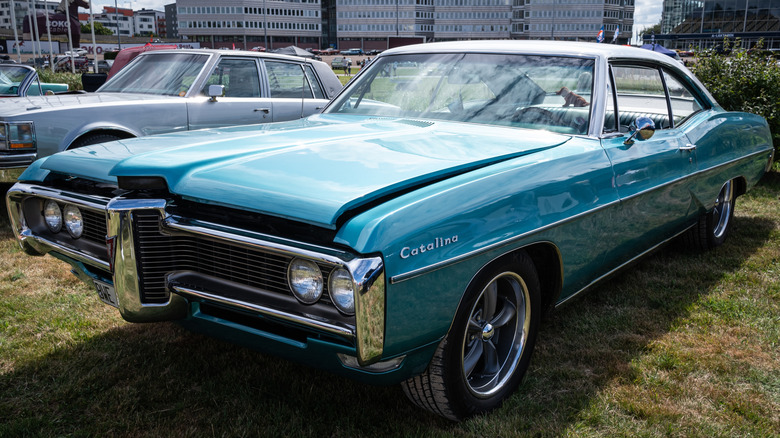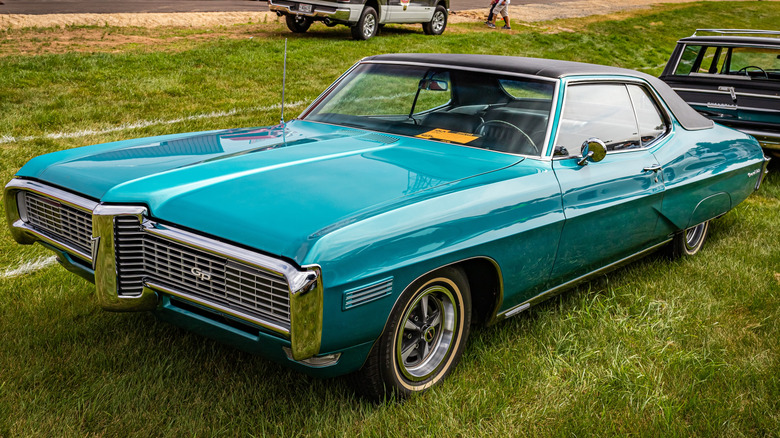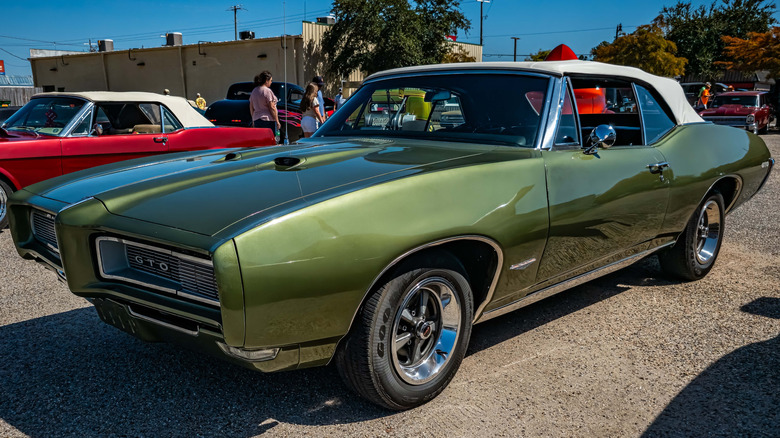Which Vehicles Were Powered By Pontiac's 428 V8 Engine?
In the late 1960s, few GM divisions were as daring as Pontiac, consistently pushing out engines that would take on whatever the muscle car era had to offer. Among their most notable offerings was the mighty Pontiac 428 V8, an engine designed not for subtlety but for sheer power. This engine, slotted into a select few cars, defined an era of raw American horsepower.
Debuting in 1967, the 428 engine not only powered cars but also fueled dreams, and its robust performance earned it a spot on our list of Pontiac's most reliable engines. While capable of propelling models like the Bonneville and Catalina, this engine was not only for cruising. It also found its way into high-performance models such as the Firebird and GTO. The 428 V8 engine was available in 1967 in two configurations: a standard 360-horsepower version and a high-output "HO" 376-horsepower version, also known as the "Quadra-Power" 428. For 1968 and 1969, these were replaced by standard 375-horsepower and high-output 390-horsepower versions.
1967-1969 Pontiac Bonneville
The Bonneville, Pontiac's flagship full-size offering, was a prime recipient of the 428 V8 engine. In 1967, the Bonneville got a thorough redesign, including a new grille-in-bumper front end and a more prominent "Coke bottle" profile. Inside, the car got a wraparound dashboard, revised instrumentation, and premium upholstery options. This model year also saw the introduction of the 400 cubic-inch V8 engine, replacing the previous 389, and the 428 cubic-inch V8, succeeding the 421. It rode on a 124-inch wheelbase and measured 222.6 inches in overall length.
For 1968, Pontiac improved the Bonneville's appearance with a new front fascia featuring side-by-side headlights. The interior was kept modern with minor interior updates, such as an optional 8-track tape player. The 428 V8 continued to be a performance highlight, while the standard 400 V8 engine's power output increased to 340 horsepower. By 1969, the Bonneville's styling evolved further, showcasing less pronounced curves, wider taillights, and a color-coded bumper insert. The 428 V8 became the standard engine this year, producing 360 horsepower and further solidifying the Bonneville's reputation as a performance-oriented cruiser.
During these years, the Bonneville came in various body styles, including a 2-door hardtop coupe, 4-door hardtop sedan, convertible, and station wagon, catering to a diverse range of customer preferences.
1967-1969 Pontiac Catalina
The Catalina, a mid-sized car in Pontiac's lineup, also offered the powerful 428 (7.0-liter) V8 engine. This engine option transformed the Catalina into a performance-focused car capable of surprising many unsuspecting drivers — even more so with the 2+2 trim, which was available until 1967. Performance figures for the Catalina 2+2 were pretty impressive. Powered by the 428 V8, it generated 375 horsepower at 5,000 rpm and a substantial 461 lb-ft of torque at 3,600 rpm. This enabled the Catalina 2+2 to accelerate from 0 to 60 mph in about 6.0 seconds, quite remarkable even by mid-1960s standards.
While less opulent than flagship models, the Catalina's interior was still well-appointed, offering comfort and practicality. The 2+2 model further enhanced the driving experience with bucket seats, a floor-mounted shifter, and optional performance upgrades for those seeking a sportier edge. Distinctive styling cues, such as split grilles and bulged fenders, emphasized its dual personality -– a family car with a hidden performance edge. As a platform for the 428 V8, the Catalina offered a taste of Pontiac's performance heritage at a more affordable price than the flagship Bonneville.
1967-1969 Pontiac Grand Prix
The 1967 Pontiac Grand Prix offered a stylish alternative to larger full-size sedans, with a long hood, hidden headlights, and a classier roofline. While aimed at the luxury segment, it did not shy away from performance. The standard engine was a 400 cubic-inch V8, generating 350 horsepower and 440 lb-ft of torque. For those seeking even more power, the optional 428 V8 delivered 360 horsepower and 472 lb-ft of torque. Interior-wise, Pontiac continued its tradition of driver-focused design. "Strato" bucket seats and a center console created a sporty cockpit feel, while the instrument cluster effectively combined functionality and style. The Grand Prix exhibited excellent road manners for its class, thanks to a well-tuned suspension, but more for the power of the 428.
For 1968, Pontiac refined the Grand Prix with a more aggressive front grille and improved taillights. The 428 V8 got a small bump in power, with the high-output version now delivering 390 horsepower, making 1968 one of the best years for the Pontiac Grand Prix. However, 1968 also marked the end of the full-size Grand Prix, as the 1969 model transitioned to a smaller platform.
1967-1969 Pontiac Firebird/GTO
Between 1967 and 1969, Pontiac's Firebird and GTO were icons of the muscle car and pony car eras, captivating enthusiasts with their bold designs and thrilling performance. Despite their status, neither model offered the potent 428 cubic-inch V8 as a factory-installed option. The GTO was equipped with the 400 V8 engine during these years. This engine was a powerhouse in its own right, with high-performance Ram Air options that maxed out to 370 horsepower in the legendary Ram Air IV. Similarly, the Firebird offered a range of engines, with the 400 V8 being its most powerful option. This engine was also used in the Firebird Trans Am package in 1969.
However, performance enthusiasts wanted more power. This led to the development of the "Royal Bobcat" program, through which Royal Pontiac offered dealer-installed 428 V8 engines. These engines were tuned to exceed the high-output rating of 390 horsepower, delivering an estimated 425 horsepower and capable of revving up to 5,700 rpm. This performance potential was evident in a 1968 Pontiac GTO modified by Royal Pontiac and tested by Car and Driver. Equipped with a Turbo-Hydramatic 3-speed automatic transmission, this GTO demonstrated impressive acceleration, achieving 0 to 60 mph in 5.2 seconds and completing the quarter-mile in 13.8 seconds at 104 mph.
